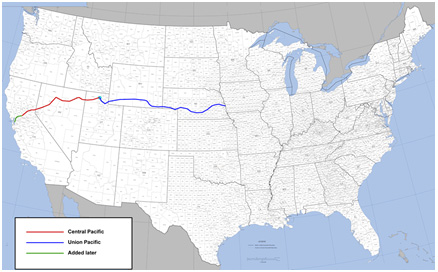
After the California Gold Rush of 1849, it became clear that the country needed a railroad that spanned the continent in order to rapidly and safely transport people to the West. The overland route over paths such as the famous Oregon Trail involved dangerous crossings into territory controlled by (justifiably) hostile American Indian tribes and over natural obstacles, especially the massive Rocky Mountains.
It did not get built right away, however, because during the 1850s, the North and South argued over the route the train should take. For example, the United States made the Gadsden Purchase from Mexico from land in Southern Arizona and New Mexico in 1853 on the strong recommendation of then-Secretary of War in order to build a Southern transcontinental railroad. Other routes were proposed that ran through the North and through the center of the United States.

Source: Transcontinental Railroad Route, Wikimedia
Secession ended the controversy. The Pacific Railroad Act of 1862 authorized the construction of the nation’s first Transcontinental Railroad and empowered to choose the easternmost terminus (ending point) of the railroad. Lincoln chose Council Bluffs, Nebraska, in the center of the country, but far north enough to avoid the fighting of the Civil War.
The Pacific Railroad Act created two companies, the Union Pacific and the Central Pacific, which would embark on a great race to construct the railroad. The Union Pacific started in Nebraska and went west. The Central Pacific started in Sacramento, California and went east.
It became a great race because the federal government incentivized each company to lay track by offering them both money and land. For each mile of track the individual company laid, it would receive cash and 10 square miles of land adjacent to the track. It took six years, from 1863-1869, to finish the railroad.
→Think Critically: Why did the payment structure setup by the federal government encourage a race between the two railroad lines?
By the time the two companies arrived in Promontory Point, Utah to lay down the final “golden” spike of the Transcontinental Railroad, the federal government had given them total acreage greater than the entire state of Texas.
![]() The Transcontinental Railroad is considered one of the greatest 19th century technological feats of the United States. Watch this short video about the Transcontinental Railroad and then answer the following questions:
The Transcontinental Railroad is considered one of the greatest 19th century technological feats of the United States. Watch this short video about the Transcontinental Railroad and then answer the following questions:
Source: Jacob Holloway – Transcontinental Railroad, BYUPodcast, Youtube
![]()